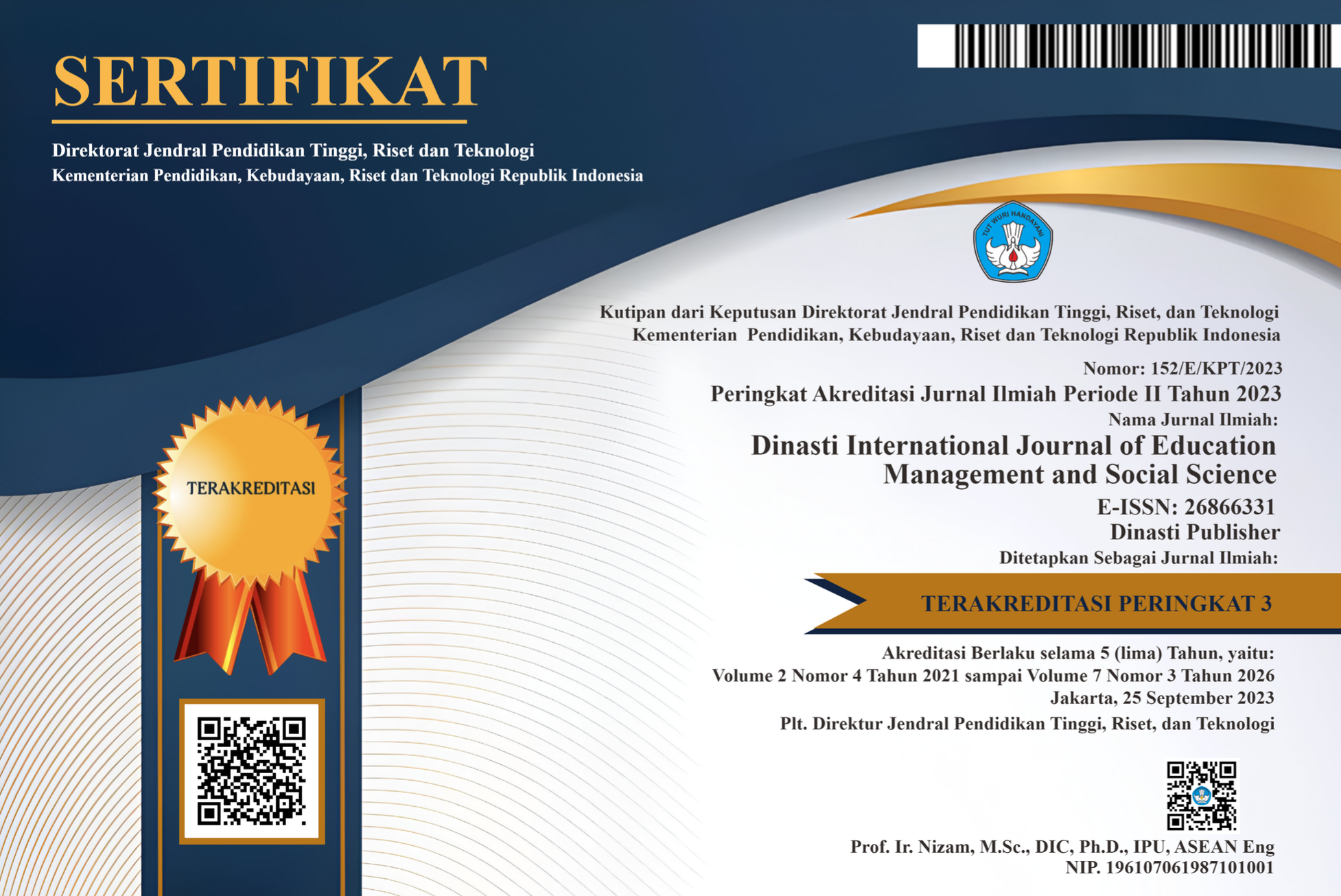Critical Discourse Analysis Ruth Wodak in The “ Bocah-Bocah Kosong” Youtube Video
DOI:
https://doi.org/10.38035/dijemss.v6i4.4448Keywords:
Entertainment Industry, Critical Discourse Analysis, Ruth Wodak, Exploitation, ManipulationAbstract
The entertainment industry is experiencing a notable evolution in humor, exemplified by the widely acclaimed content “Bocah-Bocah Kosong” on the YouTube WKWK Project by Genflix, which features women characterized by their oriental appearances and "Kosong" personas. This study seeks to elucidate the exploitation and manipulation prevalent within the entertainment industry through the application of Ruth Wodak's critical discourse analysis framework. The investigation was conducted by analyzing the textual content of episodes 1 to 30 of “Bocah-Bocah Kosong,” supplemented by interviews with four members of the production team, observational methods, and a review of relevant literature. The findings of this study, within the framework of cognitive dimension analysis, indicate that the production team engaged in exploitation throughout the entire process, from planning to scripting. The examination of the socio-psychological dimensions reveals that the manipulation of innocence, ignorance, and sexuality is employed to construct the identities of the characters in “Bocah-Bocah Kosong” through diverse modes of communication. An analysis of the linguistic dimension revealed that manipulative disclaimers were employed to evoke humor and exploit themes of innocence, ignorance, and sexuality as overarching narratives, alongside the strategic use of editing to enhance the text's impact. This manipulation is normalized by the entertainment business, which is ironic given that the owner of Genflix is a woman.
References
Abia, A., Viani, A., Silaen, J., Anggraini, J., & Hidayattulloh, W. (2023). The Basic Law of Human Stupidity: Unraveling the Dark Force Hindering Human Welfare and Happiness. AURELIA: Jurnal Penelitian Dan Pengabdian Masyarakat Indonesia, 2(2), 750–754. https://doi.org/10.57235/aurelia.v2i2.651
Acyuto, M. F., & Prasetio, A. (2023). Komodifikasi Tubuh Perempuan Melalui Pornografi Pada Podcast
Afrilya, T., Ni Wayan Suastini, & I Made Iwan Indrawan Jendra. (2021). An Analysis Types and Function of Swear Words Used in PewDiePie’s Video. ELYSIAN JOURNAL?: English Literature, Linguistics and Translation Studies, 1(1), 61–70. https://doi.org/10.36733/elysian.v1i1.1589
Ahn, J. H., & Lin, T. W. (2019). The politics of apology: The ‘Tzuyu Scandal’ and transnational dynamics of K-pop. International Communication Gazette, 81(2), 158–175. https://doi.org/10.1177/1748048518802947
Aslati, A., & Silawati, S. (2018). Fenomena Eksploitasi Perempuan Oleh Media. Jurnal Dakwah Risalah, 29(2), 133. https://doi.org/10.24014/jdr.v29i2.6389
Carter, A. (2019). ‘Essex girls’ in the comedy club: Stand-up, ridicule and ‘value struggles.’ European Journal of Cultural Studies, 22(5–6), 763–780. https://doi.org/10.1177/1367549419861852
Chaniago, R. H. (2018). Analisis Perkembangan Film Komedi Indonesia. Nyimak (Journal of Communication), 1(2), 189–195. https://doi.org/10.31000/nyimak.v1i2.482
Harrison, G. (2019). “We want to see you sex it up and be slutty:” post-feminism and sports media’s appearance double standard. Critical Studies in Media Communication, 36(2), 140–155. https://doi.org/10.1080/15295036.2019.1566628
Hati, L. P., Ginting, L. D. C. U., & Malik, R. (2022). The Exploitation of Women’s Body and Sensuality: The Attraction of Newspaper Movie Advertisements in Local Daily Newspapers. International Journal on Linguistics of Sumatra and Malay, 1(1), 30–38. https://doi.org/10.32734/ijlsm.v1i1.10571
Lee, J. (2018). East Asian “China Doll” or “Dragon Lady”? Bridges: An Undergraduate Journal of Contemporary Connections, 3(1). http://scholars.wlu.ca/bridges_contemporary_connectionshttp://scholars.wlu.ca/bridges_contemporary_connections/vol3/iss1/2
Mardiana, D. I. N. A., Nurhayani, I., & Hamamah, H. (2022). Distribusi Kata Sapaan “Arek” Dan “Bocah” Di Perbatasan Kabupaten Malang Dan Blitar. Hasta Wiyata, 5(2), 132–139. https://doi.org/10.21776/ub.hastawiyata.2022.005.02.03
Maulida, U. (2021). Pergeseran Makna Kata pada Komunikasi Generasi Alpha sebagai Kontestasi Identitas STAI Binamadani Tangerang. KODE: Jurnal Bahasa, 11(1), 38–49.
Miranti, A., & Sudiana, Y. (2020). Narasi “Cantik” sebagai Bentuk Eksploitasi Perempuan pada Pemberitaan Pedagang Perempuan Viral di Media Massa. SEMIOTIKA: Jurnal Komunikasi, 14(2), 111–120. https://journal.ubm.ac.id/index.php/semiotika/article/view/2310
Nur, E. S. (2020). Deskripsi Kualitatif Terhadap Peran Media TV Swasta Dalam Mensosialisasikan Kandidat Pilwali Di Kota Makassar. Jurnal Ilmiah Pranata Edu, 2(1), 1–16. https://doi.org/10.36090/jipe.v2i1.671
Prabowo, G. A. (2022). Komodifikasi Sedekah Di Media Youtube. Proceeding of The 2nd Conference on Strengthening Islamic Studies in the Digital Era, 2.
Ramadan, S., & Mulyati, Y. (2020). Makna Kata dalam Bahasa Indonesia (Salah Kaprah dan Upaya Perbaikannya). Ranah: Jurnal Kajian Bahasa, 9(1), 90. https://doi.org/10.26499/rnh.v9i1.1036
Raza, M., & Abdul Hamid, N. (2023). Commodification, Depiction and Objectification of Women in Pakistani Television Advertisements. Jurnal Pengajian Media Malaysia, 25(2), 17–33. https://doi.org/10.22452/jpmm.vol25no2.2
Reisigl, M., Wodak, R., Wodak, R., & Meyer, M. (2009). The discourse-historical approach. In R. Wodak, & M. Meyer (Eds.), Methods of Critical Discourse Analysis (2nd revised edition ed., pp. 87-121) (2nd ed.). Sage Publications Ltd.
Rosaria, M., & Wijaya, A. (2023). Bimbofication To Empower: Representation of Hyperfemininity on Tiktok. SUSASTRA: Jurnal Ilmu Susastra Dan Budaya, 11(1), 53–66. https://doi.org/10.51817/susastra.v11i1.123
Rully, R., Isbandi, F. S., Utomo, A. S., Khairiyah, A. S., & Apriani, W. (2021). Women’S Commodification on Tiktok: a Semiotic Study of “Elbow Sticking’’ Challenge.” Profetik: Jurnal Komunikasi, 14(2), 238–254. https://doi.org/10.14421/pjk.v14i2.2383
Seo, Y., Cruz, A. G. B., & Fifita, I. M. E. (2020). Cultural globalization and young Korean women’s acculturative labor: K-beauty as hegemonic hybridity. International Journal of Cultural Studies, 23(4), 600–618. https://doi.org/10.1177/1367877920907604
Sertta?, A., Ege, Ö., Çanakp?nar Canditate, B., & ?clal Bedir, A. (2023). Sexism and the Commodification of Women in Media: A Critical Analysis. Communication Papers-Media Literacy & Gender Studies, 12(25), 2014–6752.
Titscher, S., Meyer, M., Wodak, R., & Vetter, E. (2000). Methods of Text and Discourse Analysis. In Methods of Text and Discourse Analysis. SAGE Publications Ltd. https://doi.org/10.4135/9780857024480
Toyyib, M., Rahman, D. N., Assidiki, M. H., Zainullah, & Moefad, A. M. (2023). Objectification and Exploitation of Women’s Students Content in Social Media. East Asian Journal of Multidisciplinary Research, 2(6), 2339–2352. https://doi.org/10.55927/eajmr.v2i6.4453
Triana, N. (2021). Komika Stand Up Comedy Dalam Perspektif Industri Budaya (Studi Kasus Pandji Pragiwaksono). Jurnal Studi Komunikasi (Indonesian Journal of Communications Studies), 5(1), 165. https://doi.org/10.25139/jsk.v5i1.2952
Abia, A., Viani, A., Silaen, J., Anggraini, J., & Hidayattulloh, W. (2023). The Basic Law of Human Stupidity: Unraveling the Dark Force Hindering Human Welfare and Happiness. AURELIA: Jurnal Penelitian Dan Pengabdian Masyarakat Indonesia, 2(2), 750–754. https://doi.org/10.57235/aurelia.v2i2.651
Acyuto, M. F., & Prasetio, A. (2023). Komodifikasi Tubuh Perempuan Melalui Pornografi Pada Podcast
Afrilya, T., Ni Wayan Suastini, & I Made Iwan Indrawan Jendra. (2021). An Analysis Types and Function of Swear Words Used in PewDiePie’s Video. ELYSIAN JOURNAL?: English Literature, Linguistics and Translation Studies, 1(1), 61–70. https://doi.org/10.36733/elysian.v1i1.1589
Ahn, J. H., & Lin, T. W. (2019). The politics of apology: The ‘Tzuyu Scandal’ and transnational dynamics of K-pop. International Communication Gazette, 81(2), 158–175. https://doi.org/10.1177/1748048518802947
Aslati, A., & Silawati, S. (2018). Fenomena Eksploitasi Perempuan Oleh Media. Jurnal Dakwah Risalah, 29(2), 133. https://doi.org/10.24014/jdr.v29i2.6389
Carter, A. (2019). ‘Essex girls’ in the comedy club: Stand-up, ridicule and ‘value struggles.’ European Journal of Cultural Studies, 22(5–6), 763–780. https://doi.org/10.1177/1367549419861852
Chaniago, R. H. (2018). Analisis Perkembangan Film Komedi Indonesia. Nyimak (Journal of Communication), 1(2), 189–195. https://doi.org/10.31000/nyimak.v1i2.482
Harrison, G. (2019). “We want to see you sex it up and be slutty:” post-feminism and sports media’s appearance double standard. Critical Studies in Media Communication, 36(2), 140–155. https://doi.org/10.1080/15295036.2019.1566628
Hati, L. P., Ginting, L. D. C. U., & Malik, R. (2022). The Exploitation of Women’s Body and Sensuality: The Attraction of Newspaper Movie Advertisements in Local Daily Newspapers. International Journal on Linguistics of Sumatra and Malay, 1(1), 30–38. https://doi.org/10.32734/ijlsm.v1i1.10571
Lee, J. (2018). East Asian “China Doll” or “Dragon Lady”? Bridges: An Undergraduate Journal of Contemporary Connections, 3(1). http://scholars.wlu.ca/bridges_contemporary_connectionshttp://scholars.wlu.ca/bridges_contemporary_connections/vol3/iss1/2
Mardiana, D. I. N. A., Nurhayani, I., & Hamamah, H. (2022). Distribusi Kata Sapaan “Arek” Dan “Bocah” Di Perbatasan Kabupaten Malang Dan Blitar. Hasta Wiyata, 5(2), 132–139. https://doi.org/10.21776/ub.hastawiyata.2022.005.02.03
Maulida, U. (2021). Pergeseran Makna Kata pada Komunikasi Generasi Alpha sebagai Kontestasi Identitas STAI Binamadani Tangerang. KODE: Jurnal Bahasa, 11(1), 38–49.
Miranti, A., & Sudiana, Y. (2020). Narasi “Cantik” sebagai Bentuk Eksploitasi Perempuan pada Pemberitaan Pedagang Perempuan Viral di Media Massa. SEMIOTIKA: Jurnal Komunikasi, 14(2), 111–120. https://journal.ubm.ac.id/index.php/semiotika/article/view/2310
Nur, E. S. (2020). Deskripsi Kualitatif Terhadap Peran Media TV Swasta Dalam Mensosialisasikan Kandidat Pilwali Di Kota Makassar. Jurnal Ilmiah Pranata Edu, 2(1), 1–16. https://doi.org/10.36090/jipe.v2i1.671
Prabowo, G. A. (2022). Komodifikasi Sedekah Di Media Youtube. Proceeding of The 2nd Conference on Strengthening Islamic Studies in the Digital Era, 2.
Ramadan, S., & Mulyati, Y. (2020). Makna Kata dalam Bahasa Indonesia (Salah Kaprah dan Upaya Perbaikannya). Ranah: Jurnal Kajian Bahasa, 9(1), 90. https://doi.org/10.26499/rnh.v9i1.1036
Raza, M., & Abdul Hamid, N. (2023). Commodification, Depiction and Objectification of Women in Pakistani Television Advertisements. Jurnal Pengajian Media Malaysia, 25(2), 17–33. https://doi.org/10.22452/jpmm.vol25no2.2
Reisigl, M., Wodak, R., Wodak, R., & Meyer, M. (2009). The discourse-historical approach. In R. Wodak, & M. Meyer (Eds.), Methods of Critical Discourse Analysis (2nd revised edition ed., pp. 87-121) (2nd ed.). Sage Publications Ltd.
Rosaria, M., & Wijaya, A. (2023). Bimbofication To Empower: Representation of Hyperfemininity on Tiktok. SUSASTRA: Jurnal Ilmu Susastra Dan Budaya, 11(1), 53–66. https://doi.org/10.51817/susastra.v11i1.123
Rully, R., Isbandi, F. S., Utomo, A. S., Khairiyah, A. S., & Apriani, W. (2021). Women’S Commodification on Tiktok: a Semiotic Study of “Elbow Sticking’’ Challenge.” Profetik: Jurnal Komunikasi, 14(2), 238–254. https://doi.org/10.14421/pjk.v14i2.2383
Seo, Y., Cruz, A. G. B., & Fifita, I. M. E. (2020). Cultural globalization and young Korean women’s acculturative labor: K-beauty as hegemonic hybridity. International Journal of Cultural Studies, 23(4), 600–618. https://doi.org/10.1177/1367877920907604
Sertta?, A., Ege, Ö., Çanakp?nar Canditate, B., & ?clal Bedir, A. (2023). Sexism and the Commodification of Women in Media: A Critical Analysis. Communication Papers-Media Literacy & Gender Studies, 12(25), 2014–6752.
Titscher, S., Meyer, M., Wodak, R., & Vetter, E. (2000). Methods of Text and Discourse Analysis. In Methods of Text and Discourse Analysis. SAGE Publications Ltd. https://doi.org/10.4135/9780857024480
Toyyib, M., Rahman, D. N., Assidiki, M. H., Zainullah, & Moefad, A. M. (2023). Objectification and Exploitation of Women’s Students Content in Social Media. East Asian Journal of Multidisciplinary Research, 2(6), 2339–2352. https://doi.org/10.55927/eajmr.v2i6.4453
Triana, N. (2021). Komika Stand Up Comedy Dalam Perspektif Industri Budaya (Studi Kasus Pandji Pragiwaksono). Jurnal Studi Komunikasi (Indonesian Journal of Communications Studies), 5(1), 165. https://doi.org/10.25139/jsk.v5i1.2952
Downloads
Published
How to Cite
Issue
Section
License
Copyright (c) 2025 Hetty Mery, Elly Manika Maya Mahadi, Gesilva Putri Samya Shaabiriina, Pramudya Ardhika Hernanto

This work is licensed under a Creative Commons Attribution 4.0 International License.
Authors who publish their manuscripts in this journal agree to the following conditions:
- The copyright on each article belongs to the author(s).
- The author acknowledges that the Dinasti International Journal of Education Management and Social Science (DIJEMSS) has the right to be the first to publish with a Creative Commons Attribution 4.0 International license (Attribution 4.0 International (CC BY 4.0).
- Authors can submit articles separately, arrange for the non-exclusive distribution of manuscripts that have been published in this journal into other versions (e.g., sent to the author's institutional repository, publication into books, etc.), by acknowledging that the manuscript has been published for the first time in the Dinasti International Journal of Education Management and Social Science (DIJEMSS).















































